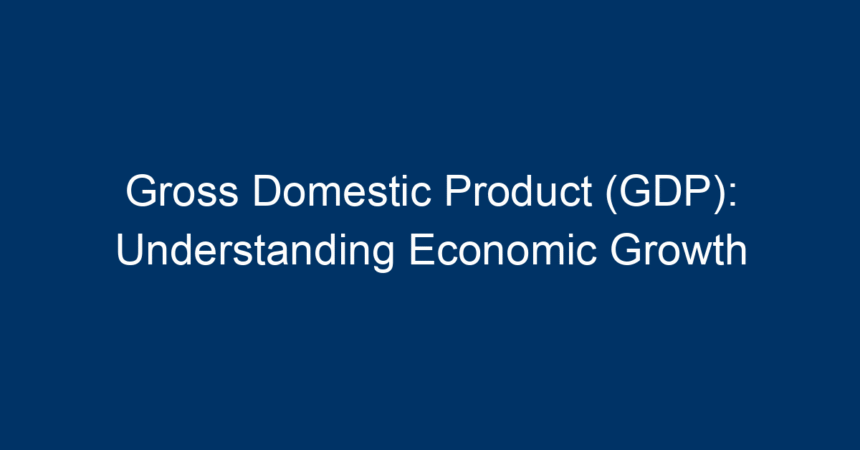Introduction
In today’s complex economic landscape, understanding the concept of Gross Domestic Product (GDP) is crucial for anyone interested in economic growth and stability. GDP serves as a benchmark for assessing a country’s economic health, influencing policy-making, investment decisions, and daily life. This article will delve into the intricacies of GDP, its components, significance, limitations, and the relationship between GDP and economic growth.
What is Gross Domestic Product (GDP)?
Gross Domestic Product (GDP) is the total monetary value of all finished goods and services produced within a country’s borders in a specific time period. It serves as a vital economic indicator, reflecting the health of an economy and providing insight into its productivity. Generally, GDP is calculated annually or quarterly, expressed in both nominal and real terms.
Nominal vs. Real GDP
When discussing GDP, it’s essential to differentiate between nominal and real GDP.
-
Nominal GDP measures the value of goods and services at current prices, without adjusting for inflation. Thus, it can give a skewed picture of economic growth, particularly in times of high inflation.
- Real GDP, on the other hand, adjusts for inflation, providing a more accurate reflection of an economy’s size and growth over time. It allows economists and policymakers to make meaningful comparisons across different time periods.
How is GDP Calculated?
There are three primary approaches to calculating GDP:
1. Production Approach
This method sums the outputs of every enterprise in the economy by subtracting the value of intermediate goods. It focuses on the actual production of goods and services.
2. Income Approach
This method calculates GDP by adding up all incomes earned by individuals and businesses in the economy. This includes wages, profits, rents, and taxes, minus subsidies.
3. Expenditure Approach
Arguably the most commonly used method, the expenditure approach calculates GDP by adding up all expenditures made in the economy. It includes:
- Consumption: Spending by households on goods and services.
- Investment: Business spending on capital goods.
- Government Spending: Expenditures on public services and infrastructure.
- Net Exports: Exports minus imports.
The formula can be summarized as follows:
[ \text{GDP} = C + I + G + (X – M) ]
where (C) is consumption, (I) is investment, (G) is government spending, (X) is exports, and (M) is imports.
The Significance of GDP
Understanding Gross Domestic Product (GDP) is crucial for several reasons:
Economic Health Indicator
GDP is a primary measure of a country’s economic performance. A rising GDP often signifies a growing economy, while a falling GDP indicates economic contraction.
Policy Making
Governments and central banks rely heavily on GDP data to shape fiscal and monetary policies. A sustained decrease in GDP may lead to stimulus measures, interest rate changes, or other interventions aimed at improving economic conditions.
Investment Decisions
Investors and analysts closely monitor GDP growth rates to make informed investment decisions. Higher GDP growth suggests a favorable business environment, attracting both domestic and foreign investment.
Global Comparisons
GDP provides a standardized measurement for comparing economies worldwide. It helps investors and policymakers evaluate which economies offer the best growth potential.
Limitations of GDP as an Economic Measure
While GDP is a critical indicator of economic performance, it has its limitations.
Ignores Income Distribution
GDP measures aggregate economic output but does not account for how income is distributed among a population. A growing GDP might coincide with increasing inequality, raising questions about whether growth benefits all citizens.
Excludes Non-Market Transactions
Many valuable activities, such as volunteer work and household chores, do not factor into GDP calculations. This exclusion means that GDP does not always reflect the true economic health of a nation.
Environmental Concerns
GDP growth may come at the expense of environmental degradation. Natural resource depletion and pollution are not deducted from GDP, potentially leading to unsustainable growth patterns.
Short-Term Focus
GDP often emphasizes short-term economic fluctuations, downplaying long-term growth drivers like education and technological advancements. This focus can mislead policymakers regarding the sustainability of growth.
The Relationship Between GDP and Economic Growth
Understanding the interplay between gross domestic product (GDP) and economic growth is essential. Economic growth is typically defined as an increase in real GDP over time. Here’s how they relate:
Drivers of Economic Growth
Economic growth can stem from various factors:
- Labor Force Growth: An increasing population or improved workforce participation can drive GDP growth.
- Productivity Enhancements: Improvements in technology or processes lead to better efficiency and higher output.
- Investment in Capital: Businesses investing in new equipment or infrastructure can increase production capacity.
- Innovation: New products and services created through research and development can stimulate growth.
GDP Growth Rates
Analyzing GDP growth rates can reveal economic trends. A consistent increase typically indicates a healthy economy, while volatility suggests underlying issues.
The Global Context of GDP
GDP Across Different Countries
Different countries have various GDP levels, influenced by multiple factors, including resources, governance, and economic policies. For example, developed countries like the United States and Germany have high GDPs due to advanced industries and higher productivity, while developing nations tend to have lower GDPs as they work towards industrialization.
Emerging Economies
Countries like India and China are seeing rapid GDP growth, driven by large populations, economic reforms, and increasing investments. Monitoring these growth rates can provide insight into shifting global economic power.
Conclusion: Actionable Insights
Understanding Gross Domestic Product (GDP) is vital for grasping economic dynamics at both national and global levels. Policymakers, investors, and citizens alike can benefit from comprehending this key economic indicator.
What You Can Do:
- Stay Informed: Keep up with quarterly GDP reports and economic forecasts.
- Educate Yourself: Explore how different factors affect GDP growth, including technology, labor markets, and fiscal policies.
- Consider the Bigger Picture: While GDP is important, also consider other indicators like income inequality and environmental health when assessing economic wellbeing.
In essence, while GDP remains a cornerstone of economic analysis, recognizing its advantages and limitations allows for a more comprehensive understanding of economic growth.




